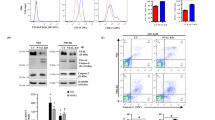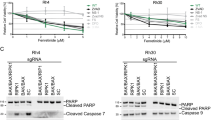Abstract
CD437-induced apoptosis has been investigated in NB4, a human t(15;17) acute promyelocytic leukemia (APL) cell line, and in the retinoic acid (RA)-resistant NB4-R1 derivative subclone. Both NB4 and NB4-R1 cells underwent rapid apoptosis in response to low doses of CD437 (10−7M). This apoptosis did not require the activation of classical retinoid receptors and like arsenic (As)-induced apoptosis was preceded by the rapid activation of a caspase-3-like enzymatic activity as indicated by the increase of DEVD-pNA hydrolytic activity, by the processing of procaspase-3 protein and by the cleavage of poly(ADP-ribose) polymerase (PARP). Furthermore, it was demonstrated that the caspase-3-like proteolytic activity is responsible for the degradation of both the PML/RARα oncogenic protein and the normal RARα proteins. In CD437-treated cells, PML proteins were not degraded and PML relocalization on PML-NBs occurred in all the cells before death. CD437-induced apoptosis and receptor degradation were proteasome independent and not influenced either by inhibitors of protein tyrosine kinases (PTK), protein tyrosine phosphatases (PTPases) and serine proteases or by glutathione levels. Moreover, our data suggested that as for As2O3-induced apoptosis Bc12 modulation is not significant for CD437-induced apoptosis of NB4 cells. Since CD437 induces in vitro the rapid apoptosis of both RA-sensitive and -resistant APL cells, it could represent the first retinoid potentially able to eradicate in vivo malignant leukemia blasts.
This is a preview of subscription content, access via your institution
Access options
Subscribe to this journal
Receive 12 print issues and online access
$259.00 per year
only $21.58 per issue
Buy this article
- Purchase on Springer Link
- Instant access to full article PDF
Prices may be subject to local taxes which are calculated during checkout
Similar content being viewed by others
Author information
Authors and Affiliations
Rights and permissions
About this article
Cite this article
Giannì, M., de Thé, H. In acute promyelocytic leukemia NB4 cells, the synthetic retinoid CD437 induces contemporaneously apoptosis, a caspase-3-mediated degradation of PML/RARα protein and the PML retargeting on PML-nuclear bodies. Leukemia 13, 739–749 (1999). https://doi.org/10.1038/sj.leu.2401419
Received:
Accepted:
Published:
Issue Date:
DOI: https://doi.org/10.1038/sj.leu.2401419
Keywords
This article is cited by
-
Many cuts to ruin: a comprehensive update of caspase substrates
Cell Death & Differentiation (2003)
-
Evidence of a lysosomal pathway for apoptosis induced by the synthetic retinoid CD437 in human leukemia HL-60 cells
Cell Death & Differentiation (2001)
-
Dissecting the pathways to death
Leukemia (2000)
-
Heat shock proteins – modulators of apoptosis in tumour cells
Leukemia (2000)



